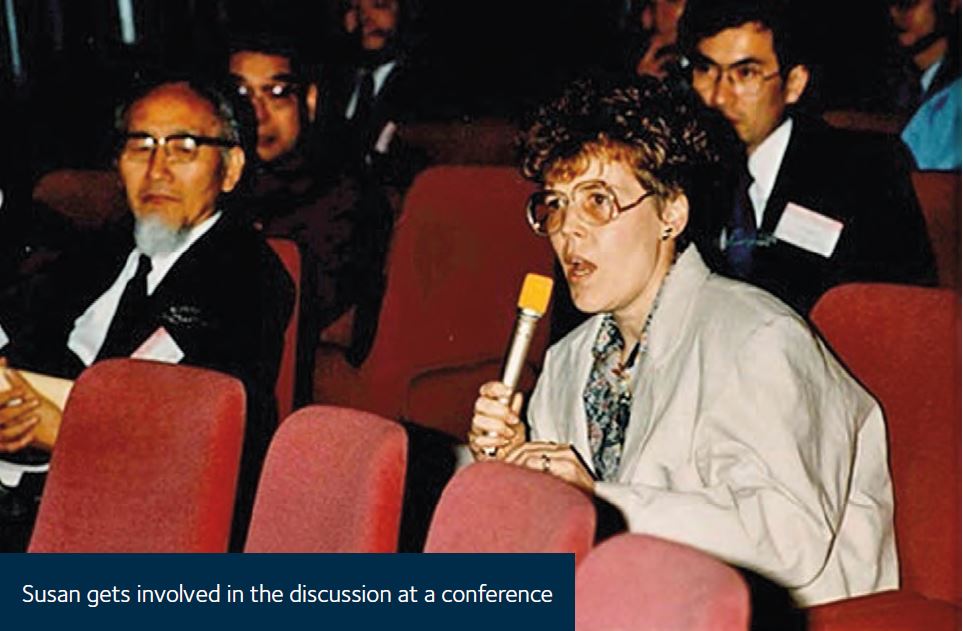
Physiology News Magazine
Obituary: Susan Noble
1940 – 2015
Membership
Obituary: Susan Noble
1940 – 2015
Membership
Dario DiFrancesco & Hilary F Brown
https://doi.org/10.36866/pn.102.42

Susan Noble who died on 4 October 2015 aged 75 had worked for many years in the Oxford cardiac group led by her husband, Denis.
Susan’s parents were both schoolteachers (of mathematics) and she was the eldest of their three children. Although always keenly interested in the arts and the theatre, she specialised in science at school, and in 1959 was accepted at Somerville College, Oxford to read for a degree in Physiology. After two years of the course, however, she became ill and had to withdraw from Oxford. On recovery, she completed her undergraduate studies at University College London. Shortly after she graduated, Susan and Denis Noble were married and in 1965, when Denis was appointed to a University Lectureship in Physiology and Fellowship at Balliol College, they settled in Oxford. Their daughter, Penny, was born in 1967 and their adopted son, Julian, joined the family in 1972.
When Susan returned to Oxford, Jean Banister, who had been her tutor at Somerville and who provided her with lifelong support and friendship, found her funding for graduate work and provided space in a corner of her own lab. Here Susan worked with others (Hilary Brown, Anne Clark and Wayne Giles) investigating the membrane currents in strips of frog atrial muscle voltage clamped using the double sucrose gap technique. Of particular interest was the induced pacemaking that resulted from applying steady depolarizing currents to atrial muscle. This type of pacemaking was shown to depend on the decay of outward potassium currents, though in multicellular preparations things are complicated by slow current changes caused by the accumulation of potassium ions in extracellular spaces.
In 1972, Susan was awarded her D.Phil. for a thesis entitled ‘Membrane currents in frog atrial muscle’. She went on to study potassium ion accumulation in detail (Noble SJ (1976). J Physiol 258, 579-613).
A classical paper with Wayne Giles (Giles W, Noble SJ (1976). J Physiol 261, 103-123) demonstrated for the first time the inhibitory action of acetylcholine on the calcium current in atrial muscle. This was the first evidence that the negative inotropic cholinergic action on the heart is attributable to calcium current inhibition.

When Dario DiFrancesco joined the group in Oxford in 1976, the investigations shifted to the very challenging technique of voltage clamp of the ‘small preparation’ of rabbit sinoatrial node impaled by two microelectrodes. A 1979 paper (Brown HF, DiFrancesco D, Noble SJ (1979). Nature 280, 235-236) first described the ‘funny current’ in sinoatrial node, an inward current activated at diastolic potentials. This was a revolutionary concept at a time when all pacemaking was thought to arise from the decay of an outward (potassium) current.
The discovery of the ‘funny’ (If) current was a milestone in the field of cardiac pacemaking. It was subsequently found in other cardiac tissues that show pacemaker activity (AV node and Purkinje tissue) and its key importance for the generation and control of cardiac rhythm has been fully recognized. Further studies of If using single cells and eventually membrane channels led several decades later to the development of the commercially available f-channel blocker ivabradine used clinically in angina and heart failure therapy.

As a mathematical biologist, Susan, with her husband, Denis, published the first numerical reconstruction of sinoatrial node electrical activity incorporating the newly described If channel which provided a theoretical validation of the new finding (Noble D, Noble SJ (1984). Proc R Soc Lond B 222, 295-304). This was written in conjunction with another paper reconstructing by computer modelling the electrical activity of cardiac cells (DiFrancesco D, Noble D (1984). Phil Trans R Soc B 307, 353-398) which was recently recognized by the Royal Society as among the most influential life sciences reports in 350 years.
Susan’s interest in mathematics – which perhaps came in part from her parents – led her to obtain a Maths degree with the Open University.
Susan had a kind and understanding nature and a talent for putting younger scientists who joined the group at their ease and helping them to integrate into the team. In the lab she was an extremely friendly and helpful colleague with quick wit, good conversation and a great sense of humour. Her cheerfulness was contagious. One of us (D.DiF.) recounted to her this scene he had witnessed soon after joining the lab: Bob Torrance—who was very large indeed—opened the swing doors into Jean Banister’s lab with such force that a big CO2 cylinder standing by the door fell down. When Susan heard the description of the huge crash, the shrieks from Jean and the baritone excuses from Bob Torrance she started to laugh so infectiously that both of them laughed till the tears ran down.
Susan was full of humanity and love of life but was constantly shadowed by ill-health. This she bravely fought with as much strength and determination as she could muster, supported in everything by her close family. But inevitably her involvement in lab-based activity declined over the years. Despite these limitations, she contributed to findings, which have been fundamental to understanding the mechanisms that generate and control cardiac pacemaking.
